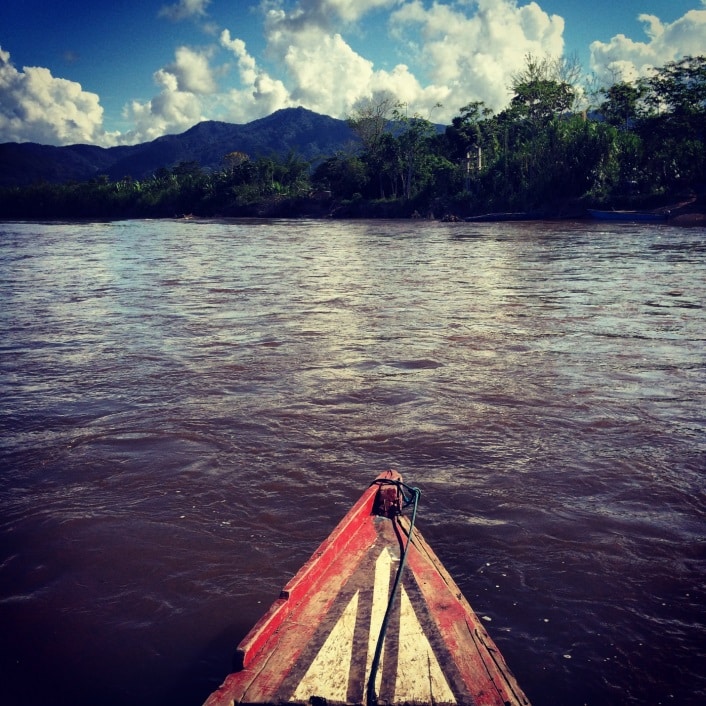
If you’ve ever been to Peru, you know that there’s almost a magical energy that permeates the country. The colors, the food, the crazy geographical diversity, the cultural heritage, pride and resilience of its remarkable people – although I’ve been to Peru many times, its novelty truly never fades and my love for it grows deeper with each plate of ceviche.
A few weeks ago, I accompanied a small group of Root Capital investors on a trip to the Peruvian countryside, getting a first-hand perspective of Root Capital’s impact by visiting coffee clients and a potential nut client in the San Martin region in the central Andes. As I boarded my flight home, I left feeling inspired and energized by the things we saw, the stories we heard, and the people we met. I think we all did.
Here are a few memorable moments from the trip:
Before we headed deep into the campo, we stumbled upon this parade in Lima celebrating indigenous cultures of the Andes. Bright blues, deep purples, big smiles and loud, rhythmic music gave us a foreshadowing of the vibrancy of the countryside as well as the culture and heritage of Root Capital’s clients.
It took eight hours and five modes of transportation (including these boats!) but we finally arrived at our client CAPEMA, a small coffee cooperative that sources from 300 coffee growers in the region.
Clockwise from top left: A CAPEMA member’s kitchen; CAPEMA members with disease-resistant seedlings; Vicente Ventura Hernandez, one of CAPEMA’s 300 members.
Vicente Ventura Hernandez is one of CAPEMA’s producer members. His farm, situated on a near 90 degree hill with rudimentary steps carved into the earth, is backbreaking to maintain. It struck me as nothing short of a miracle that he’s able to it day in and day out.
Last year, Vicente lost almost all of his coffee trees to la roya, a coffee fungus that has torn through Latin America, leaving serious economic devastation in its wake. Now, with the cooperative’s assistance, he has been replacing his affected trees with disease-resistant coffee varietals. In addition to coffee, CAPEMA has helped him and his family battle food insecurity by assisting him to diversify into other crops – cassava, banana, papaya, lemons – mainly for home consumption. He is using the support services of Root Capital’s Coffee Farmer Resilience Initiative to bolster his production and his prospects for long-term success. He told me, “I plant trees as my pension,” meaning that he believes that environmental stewardship is not only good for his land, but also for his family, his community, and our collective future.
“Root Capital gave us the confidence to succeed,” CAPEMA’s general manager Cesar Montalvan (above with raised hand) told me as we were visiting a group of farmers responsible for small-scale poultry production that improved revenues and diets. CAPEMA was founded in 2009, and Root Capital became its first lender shortly thereafter. The cooperative is now thriving, thanks in large to Cesar’s leadership. The cooperative has implemented income diversification programs and encouraged farmers to plant home gardens for home consumption. To Cesar and CAPEMA’s members, coffee plots are more than just tracks of land; they’re “mini-businesses” capable of providing sustainable livelihoods for years to come.
Clockwise from top: Indigenous sacha inchi farmers in the Peruvian Amazon; Farmers listen to broadcasts of the local amazonian cumbia while harvesting, cracking, and drying their production; Native peruvian super nut, sacha inchi, drying in the sun.
The last stop of the trip was a visit to tropical nut producers. The nut, a Peruvian superfood called sacha inchi, produces oil high in omega-3 and omega-6 fatty acids and, due to increasing demand on the export market, has been a promising crop for the Wayku, an indigenous community in the Peruvian Amazonian jungle. Before the Wayku began producing sacha inchi, farmers were cultivating crops for subsistence purposes only.
One farmer told me that they had never earned money until they began producing sacha inchi. Today, they are drastically improving their lives, one sale at a time, and accessing global markets in an unprecedented way.
For more photos from the trip, check out Root Capital’s Facebook album.









